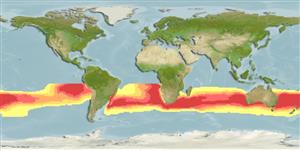Classificação / Names
Common names from other countries
Referência principal
Tamanho / Peso / Idade
Max length : 105 cm FL macho/indeterminado; (Ref. 5313); common length : 86.0 cm TL macho/indeterminado; (Ref. 9684); Peso máx. publicado: 13.7 kg (Ref. 5313)
Ambiente
; marinhas; oceanódromo (Ref. 51243); intervalo de profundidade 0 - 20 m (Ref. 86942)
Clima / Intervalo
Subtropical, preferred ?; 10°S - 50°S, 180°W - 180°E (Ref. 168)
Distribuição
Descrição breve
Espinhos dorsais (total): 15 - 18; Raios dorsais moles (total): 12-13; Espinhos anais 0; Raios anais moles: 13 - 14; Vértebras: 40. Interpelvic process small and bifid. Body naked ventrally behind the long anterior corselet. Dorsal half of body to lateral line covered with scales. Swim bladder absent. The back is bluish, turning to deep purple or almost black on the head; the belly is white, without stripes or spots; the pectoral and pelvic fins purple, their inner sides black.
Categoria na Lista Vermelha da IUCN (Ref. 115185)
Ameaça para o homem
Harmless
Utilização humana
Pescarias: pouco comercial
Mais informação
ReferênciasAquaculturaPerfil para aquaculturaEstirpesGenéticaFrequência dos alelosHereditariedadeDoençasProcessamentoMass conversion
ColaboradoresFotografiasStamps, CoinsSonsCiguateraVelocidadeTipo de nataçãoÁrea branquialOutras referênciasCérebrosVisão
Ferramentas
Relatórios especiais
Descarregue XML
Fontes da internet
Estimates of some properties based on models
Phylogenetic diversity index
PD50 = 1.0000 many relatives (e.g. carps) 0.5 - 2.0 few relatives (e.g. lungfishes)
Nível Trófico
3.7 ±0.1 se; Based on diet studies.
Resiliência
Médio, tempo mínimo de duplicação da população 1,4 - 4,4 anos (Preliminary K or Fecundity.)
Vulnerabilidade
Moderate to high vulnerability (51 of 100)
Categoria de preço
